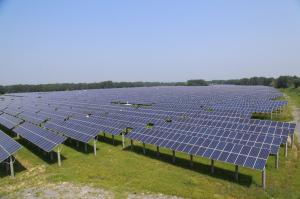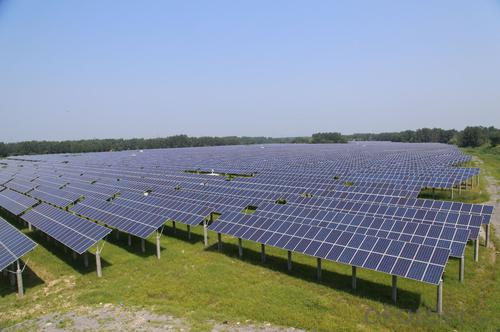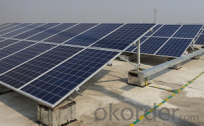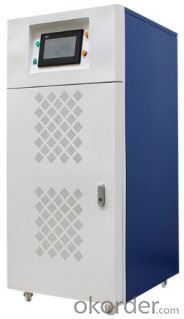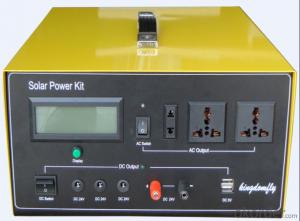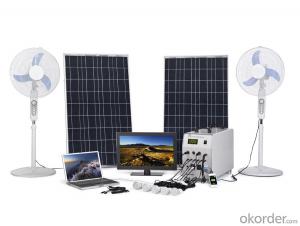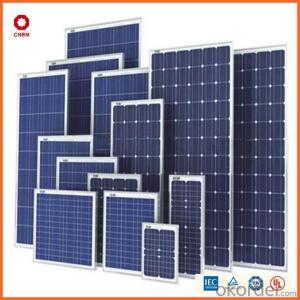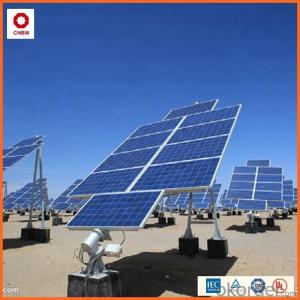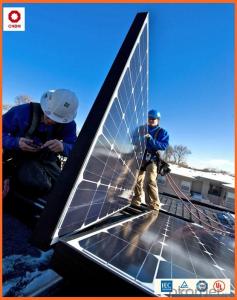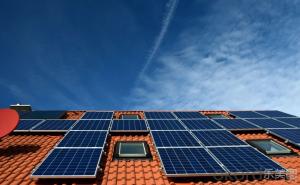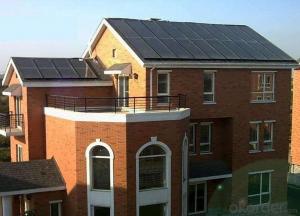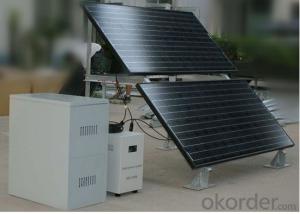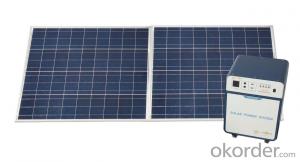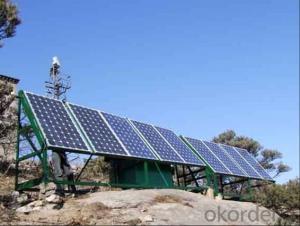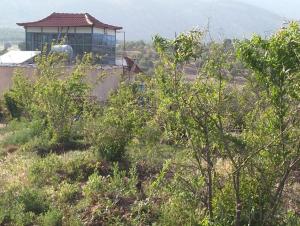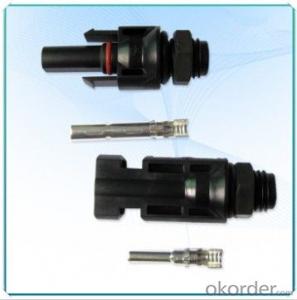30kW Solar Off-Grid Power System - Solar Energy Systems in Geelong
- Loading Port:
- China main port
- Payment Terms:
- TT OR LC
- Min Order Qty:
- 1 set
- Supply Capability:
- 500 set/month
OKorder Service Pledge
OKorder Financial Service
You Might Also Like
Specification
1. Technical parameters of 5kw Solar Off-grid Power System 30KW
-Solar panels
Power(Pmax): 300 Wp
Dimension: 1640x992x40 mm
Working Voltage(Voc): 39.7V
Working Current(Imp):9.32A
Weight: 20 kg
-PV Inverter with controller
Efficiency: >85%
Pure sine wave
AC 220V/380V 50/60Hz output
Working Temp: 0℃~40℃
Battery overvoltage protection,undervoltage protection,overload protection,short circuit protection, overtemperature protection,etc.
650*570*1270mm 180KG
-Mounting Bracket
Flat roof or Ground: Galvanized steel type;
Tile roof: Aluminium type
Wind Load Resistanc: 45m/s
Snow Load: 2kN/m2
-DC Cables
PV1-F
TUV/UL certificates
2. Products images
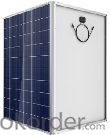
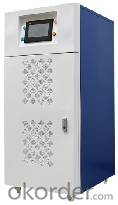
3. Product list
| No. | Item | Spec. | Qty | Unit |
| 1 | Solar Panels | 300W | 99 | pcs |
| 2 | PV Inverter with controller built-in | GSA220 | 1 | set |
| 3 | Controller | 220V 150A | 1 | set |
| 4 | Mounting racks | 30000W | 1 | set |
| 5 | DC Cables | 4mm2 | 500 | meters |
| 6 | AC Cables | 3x16+1x10mm2 | 50 | meters |
| 7 | MC4 Connectors | F&M | 40 | set |
| 8 | GEL Battery | 12V 200Ah | 54 | pcs |
4. Remark
-In rainy days, the battery can support 18500W load work 5hours.
-The maximum power load should not exceed 22KW (including inductive load impact: such as refrigerators, air conditioners, washing machines, etc. with motor load).
-The battery can be fully charged in 5-6hours under STC sunshine condition.
5. Package
Wooden case or carton pallet packing
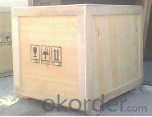
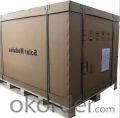
- Q: Can solar energy systems be used in areas with high levels of bird or wildlife activity?
- Yes, solar energy systems can be used in areas with high levels of bird or wildlife activity. Precautionary measures can be taken to minimize any potential negative impacts on wildlife, such as using bird-friendly designs, installing bird deterrents, and carefully selecting installation sites. Additionally, solar panels can provide shade and shelter, which can even attract certain bird species. Overall, with proper planning and consideration, solar energy systems can coexist with high levels of bird or wildlife activity.
- Q: Can solar energy systems be used in areas with high wind conditions?
- Yes, solar energy systems can be used in areas with high wind conditions. While wind turbines are typically used to harness wind energy, solar panels can still be installed and function effectively in such areas. The performance of solar panels may be slightly impacted by the presence of wind, but with proper design and installation, they can still generate significant amounts of clean energy.
- Q: What is the role of batteries in off-grid solar energy systems?
- The role of batteries in off-grid solar energy systems is to store the excess electricity generated by the solar panels during the day for use during the night or when the sun is not shining. Batteries act as a backup power source, ensuring a continuous supply of electricity and enabling self-sufficiency in remote locations or during power outages. They provide a means to store and deliver the solar energy efficiently, making off-grid solar systems more reliable and independent.
- Q: Can solar energy systems be used to power homes?
- Yes, solar energy systems can be used to power homes. Solar panels capture sunlight and convert it into electricity, which can then be used to power various appliances and systems within a home. This sustainable and renewable energy source can provide a reliable and cost-effective alternative to traditional utility electricity.
- Q: How does the efficiency of solar panels affect the performance of a solar energy system?
- The efficiency of solar panels directly impacts the performance of a solar energy system. Higher efficiency panels can convert a greater amount of sunlight into electricity, resulting in increased energy production. This means that a system with more efficient panels will generate more electricity, allowing for greater energy savings and potentially reducing reliance on other energy sources. Conversely, lower efficiency panels will generate less electricity, requiring a larger system to achieve the same energy output. Therefore, the efficiency of solar panels is crucial in determining the overall effectiveness and output of a solar energy system.
- Q: What is the role of batteries in solar energy systems?
- The role of batteries in solar energy systems is to store excess electricity generated by solar panels for use during times of low or no sunlight. This allows for constant power supply and enables the system to operate independently from the grid, increasing self-sufficiency and reliability.
- Q: What is the difference between a solar lease and a solar purchase?
- A solar lease involves renting the solar panels from a third-party provider, typically with no upfront costs but with monthly lease payments. On the other hand, a solar purchase involves buying the solar panels outright, either through a loan or with cash, and owning the system. With a purchase, there may be upfront costs, but the homeowner receives financial benefits such as tax credits and energy savings.
- Q: Can solar energy systems be used in powering sports stadiums?
- Certainly, sports stadiums can be powered by solar energy systems. In fact, numerous stadiums worldwide have already begun implementing solar energy systems to fulfill their energy requirements. To harness sunlight and convert it into electricity, solar panels can be installed on stadium rooftops, parking lots, or open areas. The primary benefit of utilizing solar energy to power sports stadiums is its sustainability and cost-effectiveness. Solar energy is a renewable energy source that doesn't emit any greenhouse gases during operation, making it environmentally friendly and assisting in reducing carbon footprint. Additionally, once the initial investment is made to install solar panels, the ongoing operational costs are relatively low, resulting in significant energy bill savings for the stadium. The size and structure of sports stadiums make them excellent candidates for solar energy systems. The stadiums' expansive surface areas provide ample space for installing a substantial number of solar panels, which can generate a significant amount of electricity. Furthermore, the open spaces surrounding the stadium allow for optimal sunlight exposure, ensuring maximum energy generation. Moreover, solar energy systems can be integrated with other technologies to enhance efficiency and functionality. For example, battery storage systems can be utilized to store excess energy generated during the day and use it during nighttime events or periods of low sunlight. This ensures a continuous and reliable power supply to the stadium, regardless of weather conditions or the time of day. In conclusion, solar energy systems can certainly be employed to power sports stadiums. They offer a sustainable and cost-effective solution to meet the energy requirements of these large facilities while also reducing their environmental impact. With further advancements in solar technology and decreasing costs, it is expected that more sports stadiums worldwide will embrace solar energy as their primary power source in the future.
- Q: Can solar energy systems be installed in areas with high wind speeds?
- Yes, solar energy systems can be installed in areas with high wind speeds. However, it is important to ensure that the solar panels and supporting structures are designed and installed to withstand the specific wind conditions in the area. This may involve using stronger materials, anchoring systems, or tilt mechanisms to minimize the risk of damage from high winds.
- Q: Can solar energy systems be used in powering amusement parks?
- Yes, solar energy systems can be used to power amusement parks. Solar panels can be installed on the roofs of buildings, parking structures, or in open spaces within the park to generate electricity from the sun. This renewable energy source can help reduce the park's reliance on traditional grid power, lower operating costs, and decrease its carbon footprint. Additionally, solar energy systems can provide a reliable and consistent source of power, making them suitable for meeting the electrical demands of amusement parks.
Send your message to us
30kW Solar Off-Grid Power System - Solar Energy Systems in Geelong
- Loading Port:
- China main port
- Payment Terms:
- TT OR LC
- Min Order Qty:
- 1 set
- Supply Capability:
- 500 set/month
OKorder Service Pledge
OKorder Financial Service
Similar products
Hot products
Hot Searches
Related keywords
